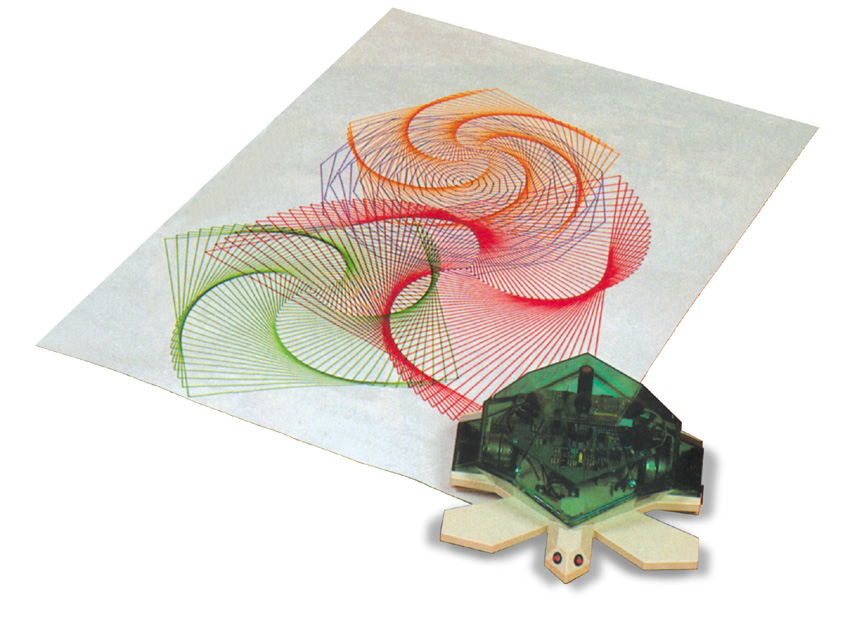Turtle (robot) on:
[Wikipedia]
[Google]
[Amazon]
 Turtles are a class of educational
Turtles are a class of educational LOGO Frequently asked Questions (FAQ): What was the genesis of Logo?
University of Hamburg, archived March 10, 2009 fro
/ref> "Irving" contained
The Story of Turtle Robots in Pictures.Articles about Turtle and Roamer robots.Photo gallery of Walter's original turtles and a Lego-based replica
about early UK analog turtle designs from the Bristol Robotics Laboratory
A Logo Primer or Whats with the Turtles
Logo Foundation. Historical robots Hobbyist robots Educational robots 1940s robots Robots of the United States Three-wheeled robots
 Turtles are a class of educational
Turtles are a class of educational robot
A robot is a machine—especially one Computer program, programmable by a computer—capable of carrying out a complex series of actions Automation, automatically. A robot can be guided by an external control device, or the robot control, co ...
s designed originally in the late 1940s (largely under the auspices of researcher William Grey Walter) and used in computer science
Computer science is the study of computation, information, and automation. Computer science spans Theoretical computer science, theoretical disciplines (such as algorithms, theory of computation, and information theory) to Applied science, ...
and mechanical engineering
Mechanical engineering is the study of physical machines and mechanism (engineering), mechanisms that may involve force and movement. It is an engineering branch that combines engineering physics and engineering mathematics, mathematics principl ...
training. These devices are traditionally built low to the ground with a roughly hemispheric (sometimes transparent) shell and a power train capable of a very small turning radius. The robots are often equipped with sensor
A sensor is often defined as a device that receives and responds to a signal or stimulus. The stimulus is the quantity, property, or condition that is sensed and converted into electrical signal.
In the broadest definition, a sensor is a devi ...
devices that aid in avoiding obstacles and, if the robot is sufficiently sophisticated, allow it some perception of its environment. Turtle robots are commercially available and are common projects for robotics hobbyists.
Turtle robots are closely associated with the work of Seymour Papert
Seymour Aubrey Papert (; 29 February 1928 – 31 July 2016) was a South African-born American mathematician, computer scientist, and educator, who spent most of his career teaching and researching at MIT. He was one of the pioneers of artif ...
and the common use of the Logo programming language
Logo is an educational programming language, designed in 1967 by Wally Feurzeig, Seymour Papert, and Cynthia Solomon. The name was coined by Feurzeig while he was at Bolt, Beranek and Newman, and derives from the Greek ''logos'', meaning 'word' ...
in computer education of the 1980s. Turtles specifically designed for use with Logo systems often come with pen mechanisms allowing the programmer to create a design on a large sheet of paper. The original Logo turtle, built by Paul Wexelblat at BBN, was named "Irving" and was demonstrated at the former Muzzey Junior High in Lexington, Massachusetts
Lexington is a suburban town in Middlesex County, Massachusetts, United States, located 10 miles (16 km) from Downtown Boston. The population was 34,454 as of the 2020 United States census, 2020 census. The area was originally inhabited by ...
.University of Hamburg, archived March 10, 2009 fro
/ref> "Irving" contained
bump
Bump or bumps may refer to:
Arts and entertainment
* Bump (dance), a dance from the 1970s disco era
* ''BUMP'' (comics), 2007-08 limited edition comic book series
Fictional characters
* Bobby Bumps, titular character of a series of American si ...
sensors and could give audio feedback with a bell. The development of the robotic Logo turtle led to the use of the term to describe the cursor in video screen implementations of the language and its turtle graphics package.
See also
* BEAM robotics, the branch of robotics pioneered in part by William Grey Walter {{Citation needed, reason=I'd go with Mark Tilden here., date=February 2022, specializing in autonomous devices using simple analog control systems * iRobot Create and its predecessor Roomba, turtle-like robots originally designed for domestic use *Player Project
The Player Project (formerly Player/Stage Project) creates free and open-source software for research into robotics and sensor systems. Its components include the ''Player'' Computer network, network Server (computing), server and the ''Stage'' p ...
, a free robotics suite.
* Curses (computer game), an interactive fiction
Interactive fiction (IF) is software simulating environments in which players use text Command (computing), commands to control Player character, characters and influence the environment. Works in this form can be understood as literary narrati ...
game by Graham Nelson
Graham A. Nelson (born 1968) is a British mathematician, poet, and the creator of the Inform, Inform design system for creating interactive fiction (IF) games. He has authored several IF games, including ''Curses (computer game), Curses'' (1993) ...
that includes a voice-operated turtle in one of its more difficult puzzles
* Unicycle cart, for a mathematical model of the dynamics of a turtle robot
References
External links
The Story of Turtle Robots in Pictures.
about early UK analog turtle designs from the Bristol Robotics Laboratory
A Logo Primer or Whats with the Turtles
Logo Foundation. Historical robots Hobbyist robots Educational robots 1940s robots Robots of the United States Three-wheeled robots